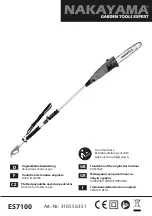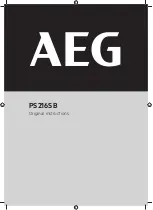
11
ASSEMBLY
CAUTION:
• Always be sure that the tool is switched off and
unplugged before carrying out any work on the tool.
Socket wrench storage (Fig. 8)
The socket wrench is stored as shown in the figure.
When using the socket wrench, pull it out of the wrench
holder. After using the socket wrench, return it to the
wrench holder.
Installing or removing saw blade
CAUTION:
• When mounting the blade, make sure that the direction
of the arrow on the surface of the blade matches the
direction of the arrow on the blade case.
• Use only the Makita socket wrench provided to install
or remove the blade. Failure to do so may result in
overtightening or insufficient tightening of the hex bolt.
This could cause a personal injury.
• Do not touch the blade immediately after operation; it
may be extremely hot and could burn your skin.
To remove the blade, use the socket wrench to loosen
the hex bolt holding the center cover by turning it coun-
terclockwise. Raise the blade guard and center cover.
(Fig. 9)
Press the shaft lock to lock the spindle and use the
socket wrench to loosen the hex bolt by turning counter-
clockwise. Then remove the hex bolt, outer flange and
blade.
(Fig. 10)
To install the blade, mount the inner flange, saw blade,
outer flange and hex bolt onto the spindle in that order.
Tighten the hex bolt by turning clockwise while pressing
the shaft lock. Return the blade guard and center cover
to its original position. Then tighten the hex bolt clock-
wise to secure the center cover. Lower the handle to
make sure that the blade guard moves properly.
(Fig. 11)
Securing workpieces
CAUTION:
• Always set the vise nut to the right fully when securing
the workpiece. Failure to do so may result in insufficient
securing of the workpiece. This could cause the work-
piece to be ejected or cause damage to the blade.
By turning the vise handle counterclockwise and then
flipping the vise nut to the left, the vise is released from
the shaft threads and can be moved rapidly in and out. To
grip workpieces, push the vise handle until the vise plate
contacts the workpiece. Flip the vise nut to the right and
then turn the vise handle clockwise to securely retain the
workpiece.
(Fig. 12)
Long workpieces must be supported by blocks of non-
flammable material on either side so that it will be level
with the base top.
(Fig. 13)
OPERATION
Cutting operation
CAUTION:
• Never attempt to cut workpieces less than 2 mm thick
except pipe or workpieces which cannot be secured
firmly with the vise. The piece cut off may be caught by
the blade, causing dangerous scattering of chips and/
or damage to the carbide-tips. Possible serious injury
may result.
• Do not apply excessive pressure on the handle when
cutting. Too much pressure may result in overload of
the motor, decreased cutting efficiency and/or damage
to the carbide-tips or blade itself.
• Too little pressure on the handle may result in more
sparks and premature blade wear.
• Do not touch the blade, workpiece or cutting chips
immediately after operation; they may be extremely hot
and could burn your skin.
• If the blade stops during operation, makes an odd
noise or begins to vibrate, switch off the tool immedi-
ately. Replace cracked or damaged blade with a new
one.
• Do not cut aluminum, wood, plastics, concrete, tiles,
etc.
• Always use carbide-tipped saw blades appropriate for
your job. The use of inappropriate saw blades may
cause a poor cutting performance and/or present a risk
of personal injury.
Hold the handle firmly. Switch on the tool and wait until
the blade attains full speed. Then lower the handle gently
to bring the blade close to the workpiece. When the blade
makes contact, ease into the cut gently at first, then grad-
ually add pressure as the cutting position steadies. Your
pressure on the handle should be adjusted to produce
the minimum amount of sparks.
When the cut is completed, switch off the tool and WAIT
UNTIL THE BLADE HAS COME TO A COMPLETE
STOP before returning the handle to the fully elevated
position. If the handle is raised while the blade is still
rotating, the piece cut off may be caught by the blade,
causing dangerous scattering of chips. When cutting only
part of the way into a workpiece, raise the handle while
the blade is rotating. Switching off during the cut may
cause damage to the carbide-tips as they contact the
workpiece.
Cutting angles (Fig. 14)
Secure the workpiece in the vise as shown in
Fig. A
, and
proceed to cut it. The saw blade life will be shortened if
the workpiece is cut as shown in
Fig. B
.
CAUTION:
• Do NOT cut the workpiece as shown in
Fig. C
since
this may cause it to be ejected from the vise, possibly
resulting in injury.
The saw blade is subjected to greater wear when the
area A in the
Fig. B
is cut. Place a wooden block up
against the workpiece as shown in the
Fig. D
so that the
saw blade will enter area A at an angle. This will help to
extend the saw blade life.
The allowable cutting dimensions are reduced when a
wooden block is used. Use a wooden block whose
dimensions are equivalent to the maximum allowable cut-
ting dimensions minus the dimensions of the workpiece
to be cut. This will further minimize the shortening of the
saw blade life.
Cutting pipes, squares and channels (Fig. 15)
The saw blade is subjected to greater wear when the
areas A and B in
Figs. F
and
G
are cut. Place a wooden
block up against the workpiece as shown in
Figs. H
and
I
so that the saw blade will enter areas A and B at an
angle. This will help to minimize the shortening of the
saw blade life.












































